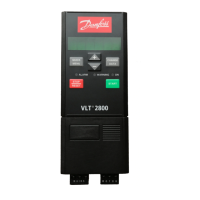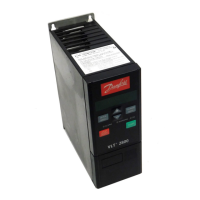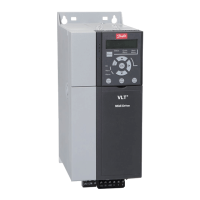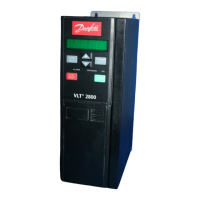Illustration 5.4 Derating for High Switching Frequency
5.1.14
Vibration and Shock
The frequency converter has been tested according to a
procedure based on the following standards:
•
IEC 68-2-6: Vibration (sinusoidal) - 1970.
•
IEC 68-2-34: Random vibration broad-band -
general requirements.
•
IEC 68-2-35: Random vibration broad-band - high
reproducibility.
•
IEC 68-2-36: Random vibration broad-band -
medium reproducibility.
The frequency converter complies with requirements that
correspond to conditions when the unit is mounted on the
walls and floors of production premises, as well as in
panels bolted to walls or floors.
5.1.15
Air Humidity
The frequency converter has been designed to meet the
IEC 68-2-3 standard, EN 50178 item 9.4.2.2/ DIN 40040 class
E at 40 °C.
5.1.16
UL Standard
This device is UL-approved.
5.1.17
Efficiency
To reduce energy consumption it is important to optimise
the efficiency of a system. The efficiency of each single
element in the system should be as high as possible.
Illustration 5.5 Efficiency vs. Load
Efficiency of frequency converters (ŋ
INV
)
The load on the frequency converter has little effect on its
efficiency. In general, the efficiency is the same at the
rated motor frequency f
M,N
, regardless of whether the
motor supplies 100% rated shaft torque or only 75%, e.g.
in case of part loads.
This also means that the efficiency of the frequency
converter does not change even if other U/f characteristics
are selected. However, the U/f characteristics influence the
efficiency of the motor.
The efficiency decreases a little when the switching
frequency is set to a value above 4.5 kHz (parameter 411
Switching frequency). The rate of efficiency is also slightly
reduced at a high mains voltage (480 V), or if the motor
cable is longer than 25 m.
Efficiency of the motor (ŋ
MOTOR
)
The efficiency of a motor connected to the frequency
converter depends on the sine shape of the current. In
general, the efficiency is just as good as in mains
operation. The efficiency of the motor depends on the
motor type.
In the range of 75-100% of the rated torque, the efficiency
of the motor is practically constant, both when it is
controlled by the frequency converter and when it runs
directly on mains.
In general, the switching frequency does not affect the
efficiency of small motors.
All about VLT 2800
Design Guide
MG27E402 Danfoss A/S © Rev. May/2014 All rights reserved. 131
5 5

